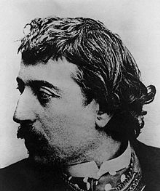
artist. He was an important figure in the Symbolist
movement as a painter, sculptor, print-maker, ceramist, and writer. His bold experimentation with coloring led directly to the Synthetist
style of modern art
while his expression of the inherent meaning of the subjects in his paintings, under the influence of the cloisonnist style
, paved the way to Primitivism
and the return to the pastoral
.
With this painting, I tried to make everything breathe faith, quiet suffering, religious and primitive style and great nature with its scream.![]()
Life at Papeete|Papeete soon became a burden.It was Europe, the Europe which I had thought to shake off — and that under the aggravating circumstances of colonial snobbism, and the imitation, grotesque even to the point of caricature, of our customs, fashions, vices, and absurdities of civilization.Was I to have made this far journey, only to find the very thing which I had fled?![]()
D'où venons-nous? Que sommes-nous? Où allons-nous?![]()
Many people say that I don't know how to draw because I don't draw particular forms. When will they understand that execution, drawing and color (in other words, style) must be in harmony with the poem?![]()
Life being what it is, one dreams of revenge — and has to content oneself with dreaming.![]()
I must confess that I too am a woman and that I am always prepared to applaud a woman who is more daring than I, and is equal to a man in fighting for freedom of behavior.![]()
A great sentiment can be rendered immediately. Dream on it and look for the simplest form in which you can express it.![]()
Nature has mysterious infinities and imaginative power. It is always varying the productions it offers to us. The artist himself is one of nature's means.![]()

